Introduction: In this article, James Pylant tells a “whodunit” story that mystified police and townspeople alike in Weston, Massachusetts, in 1904. James is an editor at GenealogyMagazine.com and author for JacobusBooks.com, is an award-winning historical true-crime writer, and authorized celebrity biographer.
Gentle, kind, and cultured Mabel Page lived a quiet life in a quaint New England hill town of less than 2,000 souls. But the 41-year-old’s death in 1904 would be remembered as “the greatest murder mystery Massachusetts has ever known,” according to two passages in the Boston Journal.
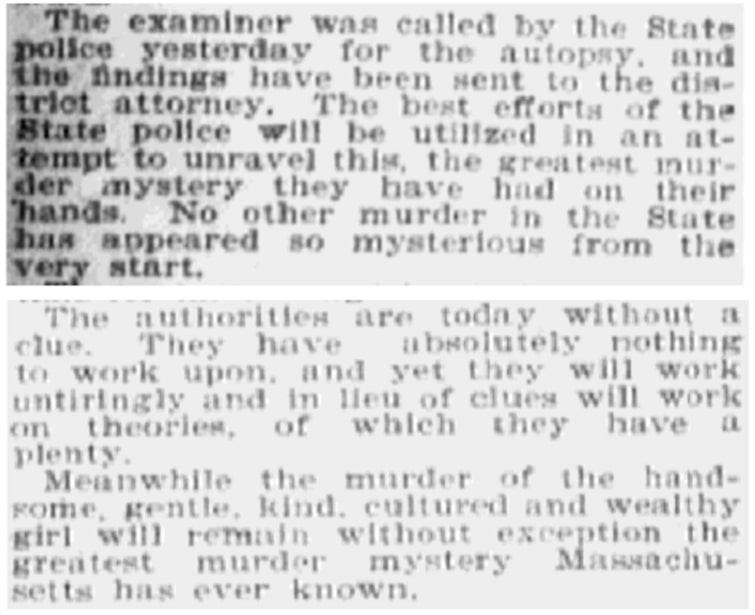
These two passages read:
The examiner was called by the state police yesterday for the autopsy, and the findings have been sent to the district attorney. The best efforts of the state police will be utilized in an attempt to unravel this, the greatest murder mystery they have had on their hands. No other murder in the state has appeared so mysterious from the very start.
The authorities are today without a clue. They have absolutely nothing to work upon, and yet they will work untiringly and in lieu of clues will work on theories, of which they have plenty.
Meanwhile the murder of the handsome, gentle, kind, cultured and wealthy girl will remain without exception the greatest murder mystery Massachusetts has ever known.
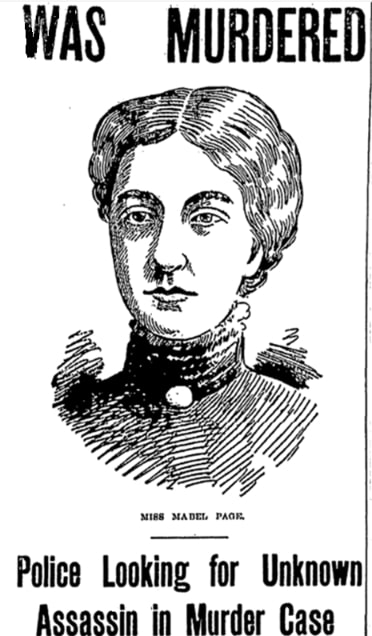
The story began with Maine native Edward Page, who came to Boston as a young man and built a fortune in the iron and steel industry.* His marriage to Elizabeth Dana Adams in 1855 was chronicled in the Congregationalist.

Through descent from Massachusetts Bay Colony immigrant Richard Dana, who settled in Cambridge in 1640, Elizabeth was a cousin to Governor John Winchester Dana of Maine. The governor’s wife, Eliza Ann Osgood, was also her cousin through another immigrant ancestor, John Osgood, who died in Andover in 1651.
Edward and Elizabeth (Adams) Page were the parents of Ruth Ann (1857), Mabel (1863), and Harold (1871). Two other children died young. The Pages lived in Boston’s affluent Back Bay, where Mabel attended private schools. She was well-educated in music and art and became a skilled embroiderer. Her brother, Harold, graduated from Harvard.
At the dawn of the 20th century, the father’s reversal of fortune caused his family to move to their summer retreat in nearby Weston permanently. Elizabeth died there at 71 in 1902. A live-in maid, Amy Roberts, had been with the Pages for a few years and soon became more like a family member than a servant.
Meanwhile, entering her 40s, Mabel lived “quiet and retired, devoted to her father and brother and a small circle of intimate friends,” according to the Boston Herald. Brother Harold, still in his early 30s, lived with them, but older sister Ruth Ann, a widow, lived in Boston with her children.
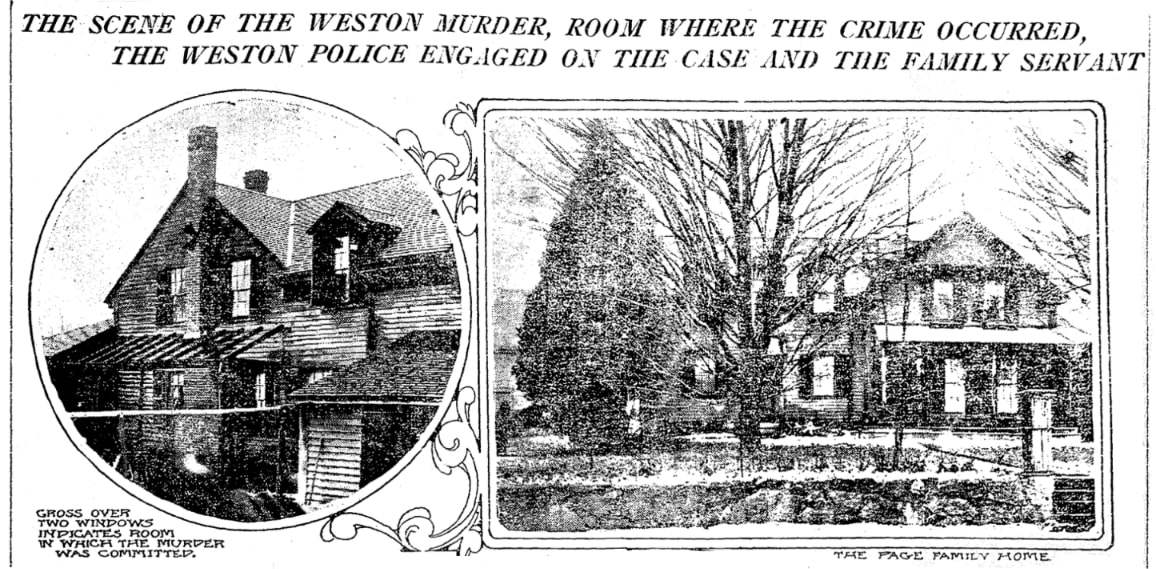
There was nothing unusual on the morning of 31 March 1904. The family gathered for breakfast at 7 o’clock; 35-year-old Harold left for work in Boston that morning between 8:45 and 8:50, Mr. Page went to Auburndale about 9:30, and the maid left for a day trip to Cambridge and Boston around 10:30. That left 41-year-old Mabel home alone.
Returning home at 2:30 p.m., Mr. Page walked to the back of the house, expecting to find his daughter as she always bolted the front door. In the parlor, it looked as if Mabel had just been there. A basket stood next to the table, where he noticed a thimble beside a cotton garment she had been making. Mr. Page went upstairs and found Mabel lying perfectly straight on her back on her bedroom floor – dressed as if she were about to step outside, complete with a hat and walking boots. Her hand was cold to the touch. “I put my head down to her chest to see if I could discover any signs of life, and her face was cold,” he explained. Mabel’s lips were slightly parted as if she were about to speak, and her eyes were opened enough so that Mr. Page could see the pupils.
And he noticed blood. He placed his hand under the chin and found her throat jaggedly cut.
Mr. Page went back downstairs, and in the living room, he found a note in Mabel’s handwriting stating:
“Have heard Harold is hurt and is at Massachusetts Hospital. Have gone in at twelve o’clock. Will leave key of front side door with key of barn stairs. Will telephone to Mrs. Bennett.”
Mrs. Bennett was a neighbor, and Mabel often used her telephone to call friends in Boston.
Mr. Page left the house immediately to alert the neighborhood of his daughter’s shocking death.
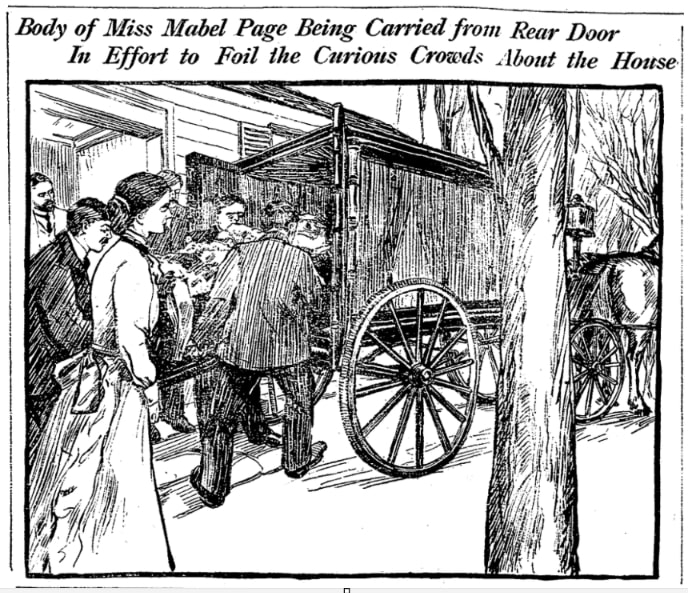
Dr. Julian A. Mead examined the body and stated her demise came “suddenly” and resulted from “internal hemorrhage.” It was an oversimplification made on April Fools’ Day that did not escape the Boston Herald. He deemed it a suicide, though he did not make that statement on the death certificate. The next day, the newspaper noted Dr. Mead failed to see the two deep cuts in her stomach. “This mistake, in connection with the cutting of the throat, led to the theory of suicide as the cause of death,” the Herald stated.
The Herald theorized that the killer arrived at the Page home with a false story that Mabel’s brother, Harold, had been injured, which caused her to write the note for her father before going upstairs to change clothes for the hospital trip to Boston, adding:
While in her room, it is supposed that the murderer stepped quickly behind her and plunged a knife into her back. As she turned to grapple with her attacker, the knife was again thrust into the pit of her stomach, inflicting a mortal wound, causing her to sink to the floor, bleeding internally, where she must have soon expired. The cutting of her throat must have followed her death.
The undertaker reported finding 13 wounds.
“I cannot understand the murder of my daughter at all, for she had no enemies as far as I know, there was no robbery, and she was not assaulted,” Edward Page told a Herald reporter.
In Lynn, Massachusetts, Caroline Sanborn Nourse obsessively followed newspaper coverage of the Page murder, reading every detail. The 65-year-old disappeared from her home on the evening of April 5, and her body was found in the dark, bottomless waters of Floating Bridge Pond in Lynn four days later.
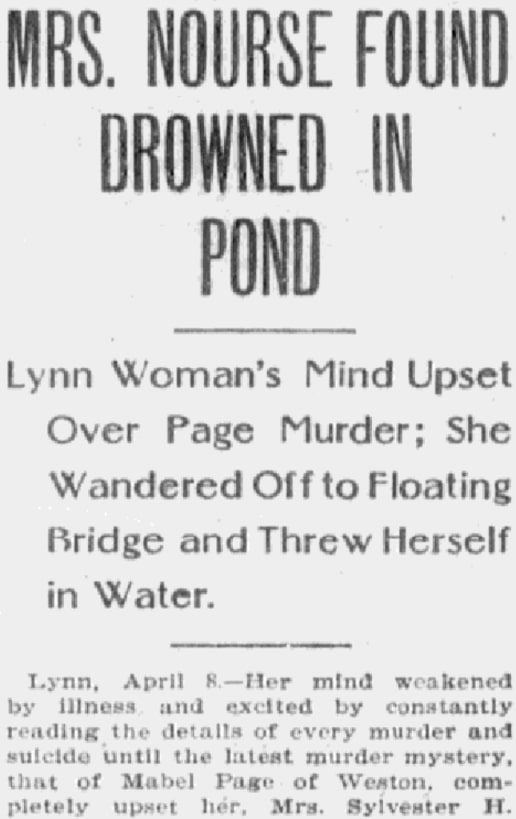
This article reports:
Her mind weakened by illness and excited by constantly reading the details of every murder and suicide until the latest murder mystery, that of Mabel Page of Weston, completely upset her, Mrs. Sylvester H. Nourse of 25 Park Street committed suicide by drowning in Floating Bridge Pond just before midnight last Tuesday.
The unsolved murder of Mabel Page spawned rumors and theories that would toss the case in different directions, whipping the press into a frenzy as strange stories emerged.
To be continued…
Explore over 330 years of newspapers and historical records in GenealogyBank. Discover your family story! Start a 7-Day Free Trial
Note on the header image: Sherlock Holmes investigates a mystery.
Illustration credit: https://depositphotos.com/home.html
* “Edward Page Passes Away,” Morning Sentinel (Waterville, Maine), 23 April 1906, p. 3.
